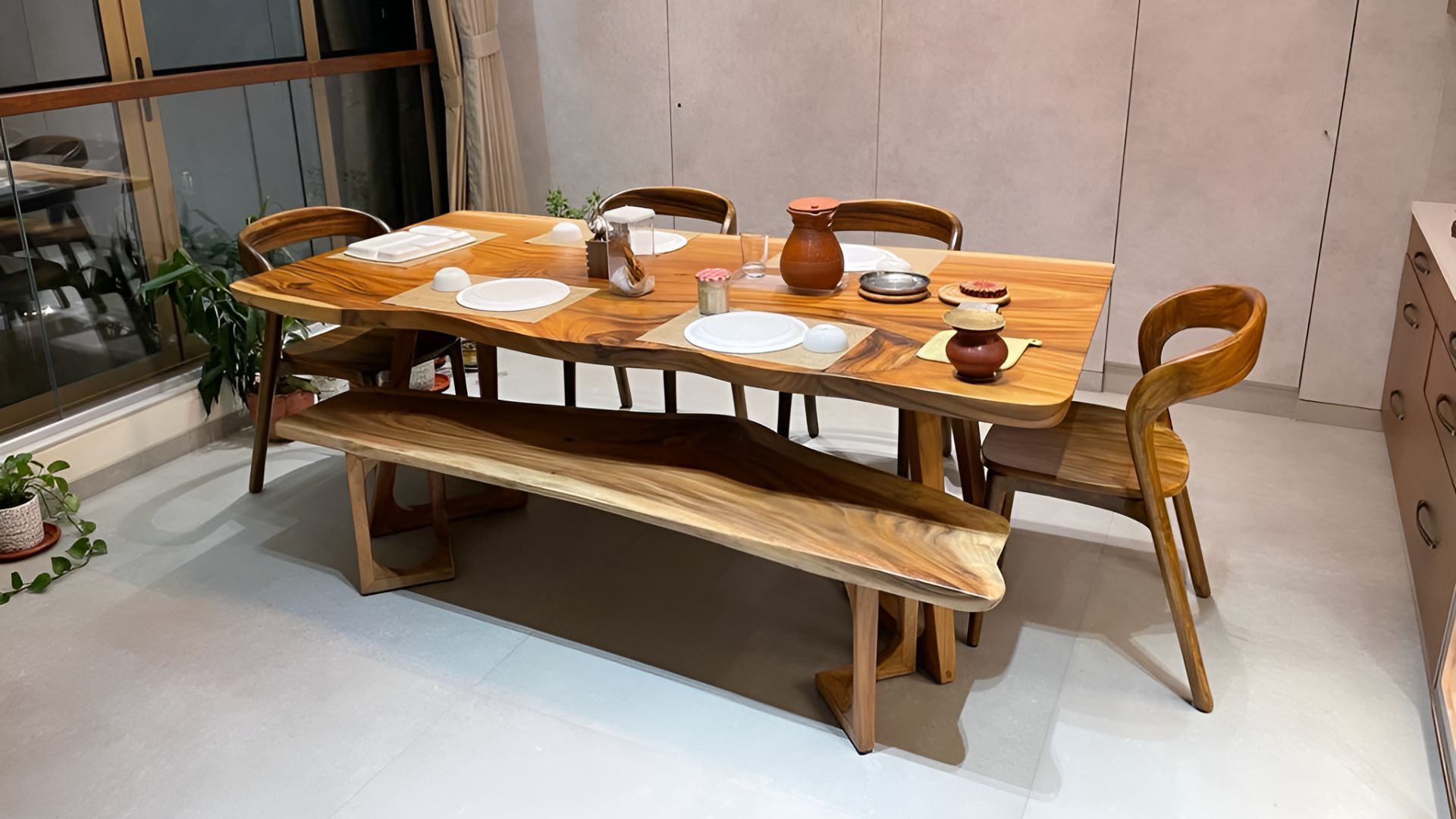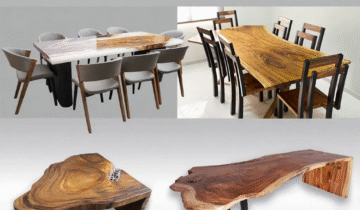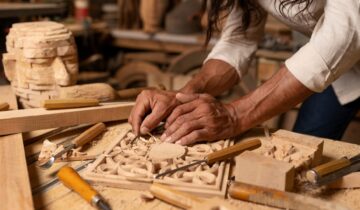General Information
Solid wood furniture is made entirely from wood that comes directly from trees. It’s not engineered or made from composite materials like particleboard or plywood. The furniture is crafted using thick, natural wood pieces, offering durability, strength, and a unique appearance with natural grain patterns.
Solid wood furniture is made from natural wood pieces, while engineered wood furniture is made from wood-based products like plywood, MDF (medium-density fiberboard), or particleboard, which are compressed and bonded together with adhesives. Engineered wood is often less expensive but lacks the durability, strength, and natural beauty of solid wood.
The benefits of solid wood furniture include its durability, strength, unique grain patterns, and timeless aesthetic. It can last for generations, ages beautifully, and can be refinished or repaired. Solid wood also has natural insulating properties, making it a great choice for comfort and sustainability.
Common types of wood used in solid wood furniture include oak, maple, walnut, cherry, teak, mahogany, pine, and ash. Each type of wood has its own unique characteristics in terms of color, grain pattern, and durability.
Solid wood furniture can be environmentally friendly, especially if it is sourced from sustainably managed forests or reclaimed wood. Look for certifications like FSC (Forest Stewardship Council) to ensure that the wood comes from responsible sources. Additionally, solid wood is biodegradable and can be recycled or repurposed.
Durability and Quality
Yes, solid wood furniture is known for its durability and strength. It can withstand daily use and can last for decades or even centuries if properly cared for. Hardwoods like oak, walnut, and maple are particularly durable.
Solid wood furniture can last a lifetime, often improving with age. Proper care and maintenance can help extend its lifespan, with some pieces even becoming more valuable as they develop a patina over time.
Solid wood furniture can be resistant to termites and pests, especially if it’s made from hardwoods like teak, mahogany, or oak, which are less likely to be attacked. However, all wood is susceptible to pests if it is not treated properly or if it is exposed to the right conditions.
Solid wood furniture is stronger due to the natural density and grain structure of the wood. It is not subjected to the same bonding processes and adhesives that engineered wood undergoes, which can make it more susceptible to damage. Solid wood is naturally more resilient and offers superior strength over time.
To identify solid wood, look for the grain pattern in the wood. Solid wood will have visible grain, and each piece of wood will be unique. Tap on the wood; solid wood produces a dense, solid sound, while engineered wood might sound hollow. You can also check the edges of the furniture; solid wood will typically have more noticeable grain and color variations, especially on the sides or legs.
Maintenance and Care
To maintain solid wood furniture, regularly dust it to prevent dirt buildup. Clean it with a damp cloth and dry it immediately to avoid moisture damage. You can also apply wood polish or a furniture wax every few months to protect the finish and restore its shine. Keep the furniture away from direct sunlight and heat sources to prevent warping.
Yes, solid wood furniture can be damaged by excess moisture or humidity, which can cause the wood to swell, warp, or crack. It’s important to wipe up spills immediately and avoid placing furniture in damp or humid areas.
To protect solid wood furniture from scratches and stains, use coasters, placemats, and tablecloths. Regularly apply a protective finish or furniture wax. You can also place felt pads under objects to avoid scratches, and avoid dragging heavy items across the surface.
Use a soft, damp cloth with mild soap or a specially formulated wood cleaner. Avoid harsh chemicals or abrasive cleaners, which can damage the finish. Dry the furniture immediately with a clean, soft cloth to prevent moisture damage.
Yes, solid wood furniture can be refinished or repolished. If the surface gets scratched or worn over time, it can be sanded down and repainted, stained, or treated to restore its original beauty.
Design and Customization
Yes, solid wood furniture can be highly customized. You can choose the wood type, finish, design, size, and features to fit your specific needs and style preferences.
Solid wood furniture can be finished with a variety of options, including oil finishes, varnish, lacquer, polyurethane, and wax. The choice of finish affects the appearance and durability of the wood, with options ranging from matte to high gloss.
Yes, solid wood furniture comes in a wide range of styles, including modern, rustic, traditional, industrial, and contemporary. The versatility of solid wood allows it to be used in almost any design aesthetic.
Yes, mixing and matching different types of wood is a popular design trend. Combining woods with contrasting colors or grains can create a unique and visually appealing look. However, it’s important to ensure that the colors and textures complement each other.
Yes, solid wood furniture is available in both modern and contemporary designs. These styles often feature clean lines, minimalism, and natural finishes that highlight the beauty of the wood grain.
Cost and Value
Solid wood furniture is more expensive due to the cost of the raw materials and the craftsmanship involved in creating each piece. High-quality wood can be costly, and solid wood furniture requires more labor and expertise to produce compared to mass-produced furniture made from engineered wood.
Yes, solid wood furniture is often worth the investment. Its durability, aesthetic appeal, and timeless design make it a long-lasting choice. It also tends to hold or increase in value over time, especially if it is well-maintained.
Solid wood furniture is generally more expensive than engineered wood because it uses natural wood, which is more costly, and the production process is more labor-intensive. Engineered wood furniture is often more affordable due to the use of recycled materials and mass production techniques.
The price of solid wood furniture is influenced by factors such as the type of wood used, the complexity of the design, the craftsmanship, the size of the piece, and the finish. Rare or exotic woods will generally cost more, while simpler designs with more common woods are less expensive.
Purchase and Delivery
You can buy high-quality solid wood furniture from specialized furniture stores, online retailers, custom furniture makers, or directly from artisans. Look for companies that focus on craftsmanship and offer a variety of wood types and finishes.
To choose the right solid wood furniture, consider the size and layout of your space, your design preferences, and your functional needs. Think about the type of wood that will complement your décor and the maintenance requirements. It’s also important to ensure the piece fits comfortably in the room without overwhelming the space.
Many furniture makers and retailers offer delivery services for solid wood furniture. Delivery charges vary based on location, size, and weight of the piece, and some may offer assembly services as well.
Yes, solid wood furniture can be shipped safely over long distances with proper packing and handling. Shipping companies typically use specialized packing materials, such as foam padding and wooden crates, to ensure the furniture arrives without damage.
Before purchasing solid wood furniture online, consider the return and exchange policies, delivery charges, and whether the company offers a warranty. Make sure to read customer reviews and check the wood type, craftsmanship, and finish options to ensure you are getting a quality piece.
Environmental and Ethical Aspects
Solid wood furniture can be sustainable if the wood is sourced from responsibly managed forests or if it is made from reclaimed wood. Look for certifications like FSC (Forest Stewardship Council) to ensure that the wood is ethically sourced.
Many reputable furniture makers source wood ethically, ensuring that it comes from forests that are managed sustainably and that their supply chains follow environmental and ethical guidelines. It’s important to ask for certifications such as FSC when purchasing solid wood furniture.
If the wood is not sourced responsibly, it can contribute to deforestation. However, many furniture makers use sustainably sourced or reclaimed wood, which helps protect forests and reduce the environmental impact of deforestation.
Repairs and Modifications
Yes, solid wood furniture can often be repaired if damaged. Minor scratches, dents, and chips can be fixed by sanding, refinishing, or filling in the affected area. More serious damage may require professional restoration.
In some cases, solid wood furniture can be resized or modified, especially if the design is simple. However, more intricate pieces may require professional help to modify without damaging the structure or aesthetics.
If your solid wood furniture develops cracks or warps, it’s best to consult a professional furniture repair specialist. Minor cracks can often be filled and refinished, while warping can be addressed by properly adjusting humidity levels or by re-gluing the joints.
Trends and Popularity
Solid wood furniture is popular due to its durability, timeless aesthetic, and the warmth it adds to any space. People appreciate its natural beauty, the uniqueness of each piece, and its long-lasting quality.
Trending designs include minimalist and Scandinavian-inspired styles, with clean lines and functional storage solutions. Rustic, industrial, and reclaimed wood designs are also gaining popularity for their character and eco-friendliness.
Yes, solid wood furniture works well in minimalist interiors, as its natural grain and simple, clean lines can complement a minimalistic design. It adds warmth and texture without overwhelming the space.






 No products in the basket.
No products in the basket.